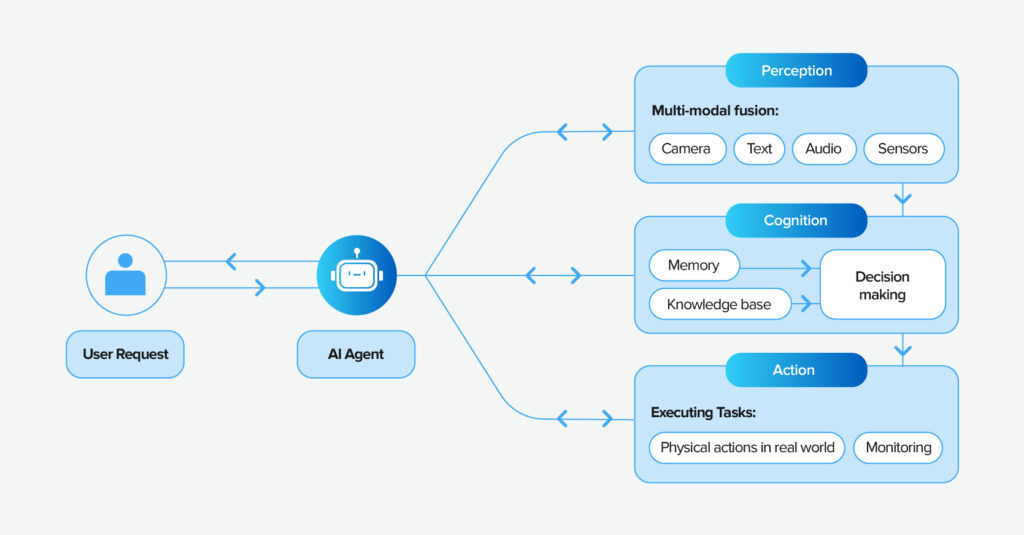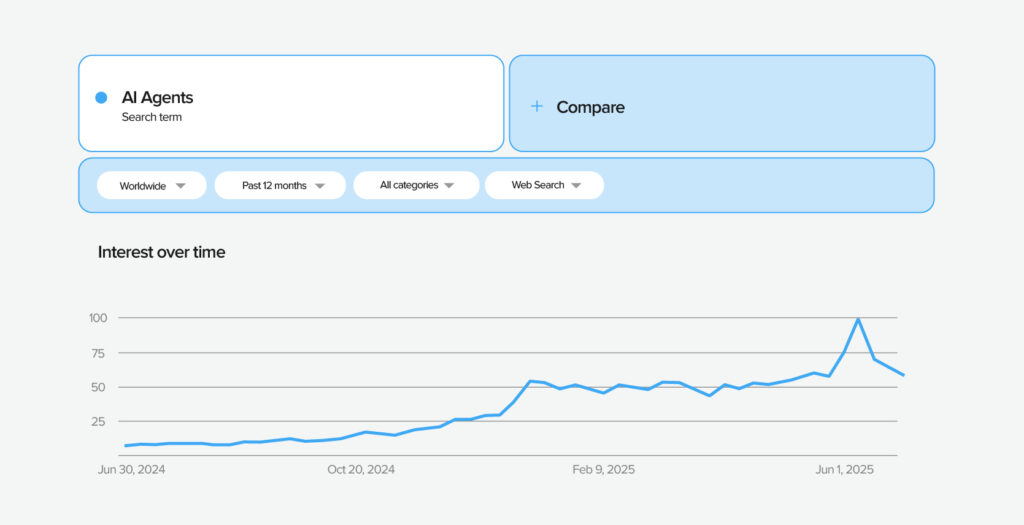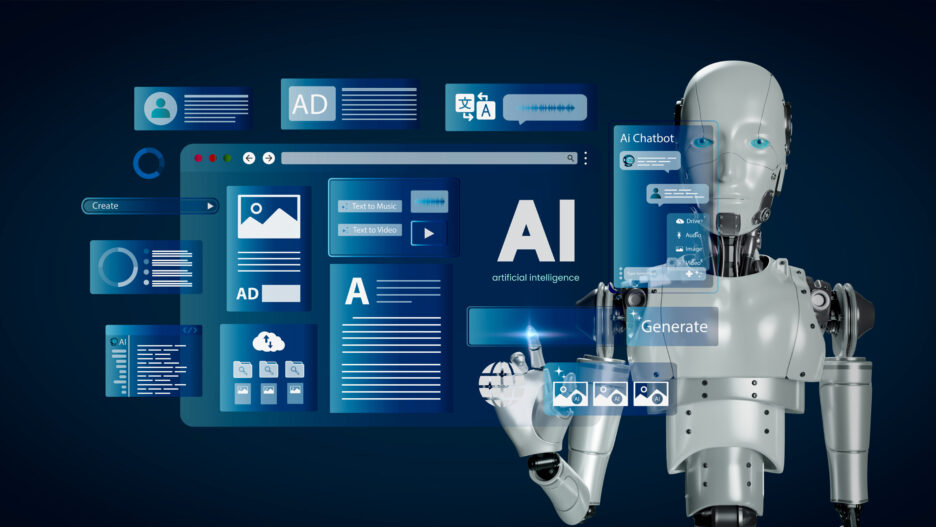AI is now on everyone’s lips. Its development has evolved from simple chatbots to advanced autonomous AI agents capable of managing specific tasks from start to finish. Businesses are on the front line of adopting AI agents into their workflows: for optimized budgeting, less manual work, better customer experience, and more.
However, success depends on how well the agent is built, the complexity of its integration, whether its functionality aligns with business process needs, and more. The first step to addressing these challenges is choosing the right AI agent development tool.
This article offers a comprehensive overview of the most popular platforms for creating AI agents, factors to consider, and a checklist with essential details to help you make the best decision for your business and maximize AI technology’s potential.
Understanding AI Agents in 2025
Agents enhance Large Language Models (LLMs) by enabling them to perform human-like tasks, which typically require specialized tools, infrastructure, and guidance. When augmented AI is combined with human oversight, it often leads to better and quicker results.
AI Agents: Key Characteristics and Operating Principles
To clarify how these assistants created with AI agent development tools differ from other AI systems, consider the main features virtual agents typically possess.
- Independent operation and decision making
Agents operate autonomously by sensing their environment, analyzing it, and acting to meet goals. For instance, a smart thermostat changes the temperature according to occupancy patterns and energy-saving preferences.
- Flexibility and learning
Agents evolve and improve with experience and feedback, similar to a virtual assistant that refines its responses by learning from user preferences and past queries.
- Collaboration and integration
Agents communicate directly with their environment or users through real-time, adaptable responses that adjust based on immediate feedback. For instance, a chatbot on a customer service platform shows this ability.
- Proactivity
Unlike basic programs that only follow instructions, intelligent agents act intentionally. They foresee needs and address problems proactively, making them helpful partners, not just mere tools.
Effective agentic frameworks are built on guiding principles that shape behavior, adaptability, and therefore become the best tools for AI agent development. These practical principles guide system design across applications such as chatbots and research tools. Since AI emphasizes autonomy, it's essential for developers to understand these fundamental truths when expanding AI agent systems.
Briefly, the process includes the following stages:
- Perception
- Cognition
- Action

Source: orq.ai
Market Trends for 2025 and Beyond
A strong combination of advancements and demand has made 2025 a breakout year for agentic AI, namely:
- Enhanced analytical skills enable independent decision-making in complex business environments.
- Decreased setup costs with cloud platforms make enterprise-level agents available to businesses of all sizes.
- Verified investment payoff models demonstrate that companies can achieve efficiency gains of up to 40% through automating business processes.
- Transparent regulatory standards presented by emerging AI governance frameworks provide more straightforward guidelines for the responsible deployment of virtual agents.
“I think 2025-2035 is the decade of agents… you’ll spin up organizations of Operators for long-running tasks of your choice.” – Andrej Karpathy, OpenAI co-founder, ex-director of AI at Tesla.
Supporting the AI leader’s perspective, here’s a chart showing interest in agentic AI based on Google Trends over the past year.

Source: apideck.com
The top 5 agentic AI trends for 2025 are:
- Business-wide intelligent agent integration
- Collaborative AI system structure
- Evolving AI communication capabilities
- Industry-specific agent creation
- Robust AI safety protocols.
Additional upcoming trends include autonomous process optimization, real-time decision-making, and integration with robotic process automation (RPA), among others.
Most Common Business Use Cases
Certainly, many businesses benefit from using AI agent development tools to build in-house smart agents, but some processes can be entirely revolutionized. Here are the leading agentic AI applications that will deliver the greatest business value in 2025.
Context-driven knowledge assistants
Intelligent agents don’t just perform simple searches – they now provide precise, context-aware information and dynamic answers tailored to your business’s real-time needs. They act like proactive copilots, instantly addressing queries using live data and internal resources.
Processes that benefit the most: Sales support, compliance checks, legal research.
Intelligent workflow orchestrators
Smart decision-making allows agents to independently handle complex, multi-stage tasks, enhancing workflows and increasing operational efficiency.
Processes that benefit the most: HR onboarding, procurement workflows, marketing campaign management.
Smart UI navigators
Mimicking human interaction with digital interfaces, agents intelligently navigate apps and websites to perform tasks such as data entry or scraping. Adaptable, context-aware abilities allow them to improve traditional automation.
Processes that benefit the most: Form automation, report extraction, web data collection.
Specialized task agents
Designed for accuracy, they focus on specific tools or tasks such as drafting emails or updating CRM, ensuring seamless workflow integration.
Processes that benefit the most: Lead generation, email management, customer support automation.
Conversational voice assistants
Natural language fluency allows smart agents to manage real-time voice interactions, such as resolving support queries and conducting interviews. Their ability to scale and respond quickly makes them essential in various industries.
Processes that benefit the most: Sales lead qualification, customer support, healthcare patent triage.
Despite the clear benefits, it’s important to understand the challenges that AI agent implementation introduces to current business processes so they can be identified and addressed promptly.
Key Factors in Choosing an AI Agent Development Tool in 2025
When selecting a suitable tech stack for developing AI agents for your business workflows, it’s crucial to identify which criteria to prioritize first. Different agent frameworks offer various features. To save time browsing through numerous options, we’ve compiled a brief list of key factors to consider before making your decision.
| Factor | What it means for your business processes |
| Task complexity | The AI agents you plan to create will perform particular tasks. That’s why you need to determine the task complexity level and whether the chosen framework is appropriate for building these specific agents. |
| Skill level | No matter how versatile the tech stack is, if your development team encounters significant challenges using it, it’s better to select a different, more user-friendly platform. |
| Scalability | Right now, you might have a short-term plan using agentic AI. However, it’s wise to consider |
| Security | To ensure your data protection, it’s crucial to verify the security policy, including data encryption and access controls, of the AI agent development tool you select. |
| Integration capabilities | Since your business already has an existing tech stack, it’s crucial to understand how well the agent development platform integrates with the tools your team currently uses. |
| Cost | The initial cost might not be the most important factor; return on investment (ROI) is the key indicator. Think about using a paid platform that ultimately delivers your organization a triple ROI compared to a free tool with little to no financial refunds. |
| Customization | This item can combine several of the previously mentioned features, such as ease of use, integrations, data handling, and more. The best tool for AI agent development must be flexible enough and easily customizable to meet the requirements of your business process at each specific stage. |
| Performance | The framework’s performance metrics encompass monitoring tools, response time, and processing speed dynamics based on data volume, among others. |
Comparison of Top AI Agent Development Tools 2025
Although still a relatively new industry, the market demonstrates considerable diversity with various vendors specializing in certain use cases and target audiences. In this context, agent builders are responsible for the complex integration of language models, storage solutions, external tools, APIs, and reasoning processes. Besides, they often support tasks such as tool-chaining, goal tracking, orchestration, and multi-agent collaboration.
Description of Tool/Platform Types
Before comparing AI agent development tools, let’s briefly examine the platform types based on accessibility, customization, and deployment context to narrow down the options for your specific business requirements.
No-code platforms allow users with little or no coding experience to create AI agents through visual interfaces, pre-made templates, and integrations. That’s why they are ideal for non-technical users, startups, or quick prototyping. Additionally, no-code platforms often feature drag-and-drop builders, pre-integrated AI APIs, and workflows for automation or chatbots.
Pros: Fast development, easy to use, low entry barrier.
Cons: Limited customization, reliance on platform constraints.
Use Cases: Creating simple chatbots, automating workflows, or developing AI-driven apps for small businesses.
Examples: Airtable (with AI automation), Bubble (with AI plugins), Zapier (with AI capabilities).
Open-source platforms are freely available AI agent development tools that offer high flexibility for developers to build and customize agents, often requiring technical expertise. They provide support for custom model training, agent memory, tool integration, and multi-agent systems. Open-source platforms are often community-driven with extensive documentation.
Pros: Highly customizable, free (excluding compute costs), large community support.
Cons: Requires coding skills, steeper learning curve, and self-managed infrastructure.
Use Cases: Creating task-oriented agents (e.g., research, coding assistants), experimental AI, or highly customized solutions.
Examples: LangChain, AutoGen, CrewAI.
Enterprise platforms are built for large-scale, business-oriented agent deployment, often offering robust support, security, and integration with current systems. They feature scalable cloud infrastructure, ready-made AI models, enterprise-grade security, and integration capabilities with complex systems. Additionally, they usually include analytics and compliance tools.
Pros: Scalability, professional support, smooth integration with enterprise ecosystems.
Cons: High costs, potential vendor lock-in, complex setup for smaller teams.
Use Cases: Customer service bots, process automation, data-driven decision-making, or industry-specific AI agents.
Examples: Microsoft Azure AI, Google Cloud AI, IBM Watson.
Top 10 Most Popular AI Agent Development Tools in 2025
The current AI market definitely features a longer list of software solutions that specialize in building smart agents. As an example, we selected ten tools based on their characteristics and other factors that make them among the most often used today.
| Name | Type | Key Features | Cost | Best for |
| AutoGen | Open-source, Low-code | - Multi-agent, - Customizable roles - API integration | - Free (open-source) - LLM API costs | - Developers, - Research teams - Multi-agent systems |
| Botpress | Open-source, Low-code | - Visual editor - NLP - Multi-platform integration - Enterprise-grade security | - Free (open-source) - Enterprise plans (custom pricing) | - Large Businesses - Scalable chatbots |
| CrewAI | Open-source, No/Low-code | - Role-based agents - 700+ app integrations - UI Studio - Supports complex workflows | - Free (open-source), - Enterprise pricing | - Enterprises - Multi-agent systems - Research assistants - Code reviewers |
| Dify | No-code, Open-source | - Drag-and-drop - Multi-LLM - RAG (Retrieval-Augmented Generation) - Document generation | - Free (open-source) - Cloud tiers | - Non-technical teams - Startups |
| FlowiseAI | Open-source, Low-code | - Node-based editor - LLM orchestration - Self-hosting | - Free (open-source) - Cloud tiers | - Developers - LLM prototyping |
| Gumloop | No-code, SaaS | - Drag-and-drop - Task automation - API integration | - Freemium, - Starter, Pro, Enterprise plans | - Marketing - Small businesses |
| LangChain | Open-source, Low-code | - Modular agents - RAG - Enterprise-grade deployment via LangSmith | - Free (open-source) - Commercial licenses | - Developers, - Data-intensive workflows |
| Microsoft Copilot Studio | No-code, Enterprise | - Graphical UI - Microsoft 365 integration | - Microsoft subscription | - Microsoft 365 users - Businesses (all sizes) |
| Relevance AI | No-code | - Visual UI templates - HubSpot and Salesforce integration | - Free tier, - Paid plans | - Non-technical teams, - Automation |
| Vertex AI Agent Builder | No-code, Enterprise | - No-code, Google Cloud - ML models - HIPAA/SOC compliance | Pay-as-you-go | - Google Cloud users - Enterprises |
Ultimate Checklist for Choosing the Best Tools for AI Agents Development
Gathering all the information we’ve discussed, here’s a checklist to help you accurately determine which platform suits your business needs based on each key criterion.
Defining Common Use Cases
The question “What for?” is the first step in identifying most business processes and beyond. Imagine that your team has already created an AI agent – what actions will it perform? For example, it can be:
- Customer service automation
- Data analysis and insights
- Workflow automation
- Predictive analytics
Each of these and other use cases demands specific capabilities from the tech stack, such as real-time processing, scalability, data sensitivity, and more.
Example: For a customer service chatbot, the stack might include Python, LangChain for conversational workflows, and cloud platforms like Google Cloud for scalability.
Validation tip: How will my team use the agents they develop on this platform?
Best platforms: Depends on your business’s specific use cases.
Assessing Team Skills
To effectively balance your team skills and the AI agent development tools:
- Leverage existing strengths to boost productivity.
- Reduce the learning curve with thorough onboarding, extra training, and dedicated support.
- Assess your team’s upskilling opportunities to embrace new tools for long-term projects.
If it’s difficult to accurately assess your team’s skill level, consider opting for a beginner-friendly solution with a no-code interface and pre-built agent templates.
Example: A Python-savvy team can utilize LangChain for building conversational agents or AutoGen for multi-agent systems.
Validation tip: What specific programming languages, frameworks, and tools is your team currently skilled in?
Best platforms: No-code and low-code options are the best choice for teams with limited technical expertise. Tech-savvy teams can utilize advanced frameworks like TensorFlow or PyTorch alongside cloud platforms such as AWS or Google Cloud to build customizable, scalable AI agent solutions.
Evaluating Integration Needs
When evaluating the integration features of the platform you're considering, focus on:
- Existing systems and tools
- Data sources
- APIs and interoperability
- Real-time requirements
- Scalability and compatibility
Example: For workflow automation, a team can use AutoGen for multi-agent coordination, connected to Notion via APIs, with Apache Kafka for real-time data processing.
Validation tip: What are the specific data formats, protocols, or other requirements for integrating with the systems your team currently uses?
Best platforms: LangChain, AutoGen, ServiceNow AI Agent Studio (for enterprises), and Relevance AI (for no-coders).
Budget Considerations
A cost-effective tech stack should optimize return on investment (ROI) while fulfilling performance and scalability requirements. That’s why the key factors to consider include:
- Hardware and infrastructure
- Software and licensing costs
- Development and maintenance
- Team training and hiring
- Scalability costs
Example: Choosing open-source AI agent development tools such as TensorFlow or PyTorch can lower licensing costs compared to proprietary options, but might require investing in skilled personnel or training.
Validation tip: What’s your AI agent project budget, and how do you prioritize cost versus scalability?
Best platforms: LangChain, AutoGet, CrewAI, Stack AI, and Google Cloud Vertex AI Agent Builder.
Scalability Tests
A scalable tech stack prevents bottlenecks, ensures quick responses, and supports long-term project success. The main areas for scalability testing include:
- Data scalability
- Computer scalability
- User load scalability
- Integration scalability
Example: Netflix’s use of TensorFlow and AWS for scalable personalization demonstrates how a well-tested stack handles millions of users.
Validation tip: Can the platform handle growth in data, users, or complexity without performance degradation?
Best platforms: LangChain, AutoGen, CrewAI, Google Cloud Vertex AI Agent Builder, and Microsoft Azure AI Agents.
Prototyping and Iteration
In brief, prototyping enables teams to quickly and cost-effectively test agent concepts to ensure the tech stack matches use case requirements. Iteration, in turn, involves building, testing, and refining prototypes based on feedback and performance metrics. Here are some practical recommendations:
- Start small with a single use case.
- Use open-source platforms to reduce costs during testing.
- Test integrations early to validate connections.
- Iterate based on the metrics received.
- Select prototyping tools that can transition to production.
Example: Companies like Airbnb use iterative prototyping with TensorFlow and cloud infrastructure to test AI-driven recommendations.
Validation tip: What core functionalities and integrations do you need to test in your AI agent prototype, and how quickly should you iterate to validate scalability performance?
Best platforms: Stack AI, AgentChat, and LangChain.
DIY AI Agent Creation vs. Outsourcing to Experts: What’s the Best Choice?
And now, let's explore an alternative perspective on AI agent development: outsourcing to expert providers. Both DIY agent creation and outsourcing have their benefits and challenges, depending on your business’s resources, expertise, and goals. For a clearer understanding, look at the comparison chart of these two approaches.
| DIY Agent Creation | Outsourcing to Experts | |
| Overview | Building agents in-house using internal teams and AI agent development tools. | Hiring specialized AI teams to develop, train, and deploy tailored agents. |
| Pros ✅ | - Full control (total ownership over design and intellectual property) - High customization (agents for exact business needs) - Cost savings long-term - Team growth (in-house AI expertise for innovation) | - Expert access (leveraging AI, ML, and data engineering skills) - High customization (agents for exact business needs) - Speed (faster delivery with pre-built frameworks) - Scalability (flexible resource allocation) - Lower risk (experts manage compliance and security) |
| Cons ❌ | - Initial costs (investment in talent and tools) - Time-consuming process (longer development, compliance check, and testing cycles) | - Dependency (reduced oversight over development and reliance on the vendor for updates) |
Why Choose an External Provider for Agent Development?
Outsourcing for agent building rather than focusing on the best tools for AI agent development brings expertise and speed to the process. As a top-notch provider, Svitla Systems delivers innovative AI solutions for various industries, including healthcare and hospitality. Their flexible models, such as managed services, team extensions, or development centers, let you access elite talent without building a team from scratch. For example, Svitla’s collaboration with Logitech on AI-enhanced firmware clearly demonstrates their ability to deliver customized, cutting-edge results. With a clear discovery phase and access to global talent, Svitla enables fast, scalable, and budget-friendly AI deployment.
Here’s what our clients say about collaborating with the Svitla team:
“We really consider this team an extension. They suggest, they challenge, they say that you should do certain things because it’s the right way.” – Nachi Sendowski ,CTO & SVP Engineering, Inflection.
Summing Up
If your business faces the challenge of developing an in-house AI agent, don't worry — just follow this checklist: consider your business use cases, assess your team's technical expertise, evaluate your budget, and review platform features. With a suitable tech stack, agent development isn't rocket science. And remember, there’s always a more reliable, less risky, and stress-free way to develop AI — outsourcing to external experts.
Contact us, and together we’ll find the best way to meet your business needs through AI development while relieving your team from complex technical issues and compliance challenges.





